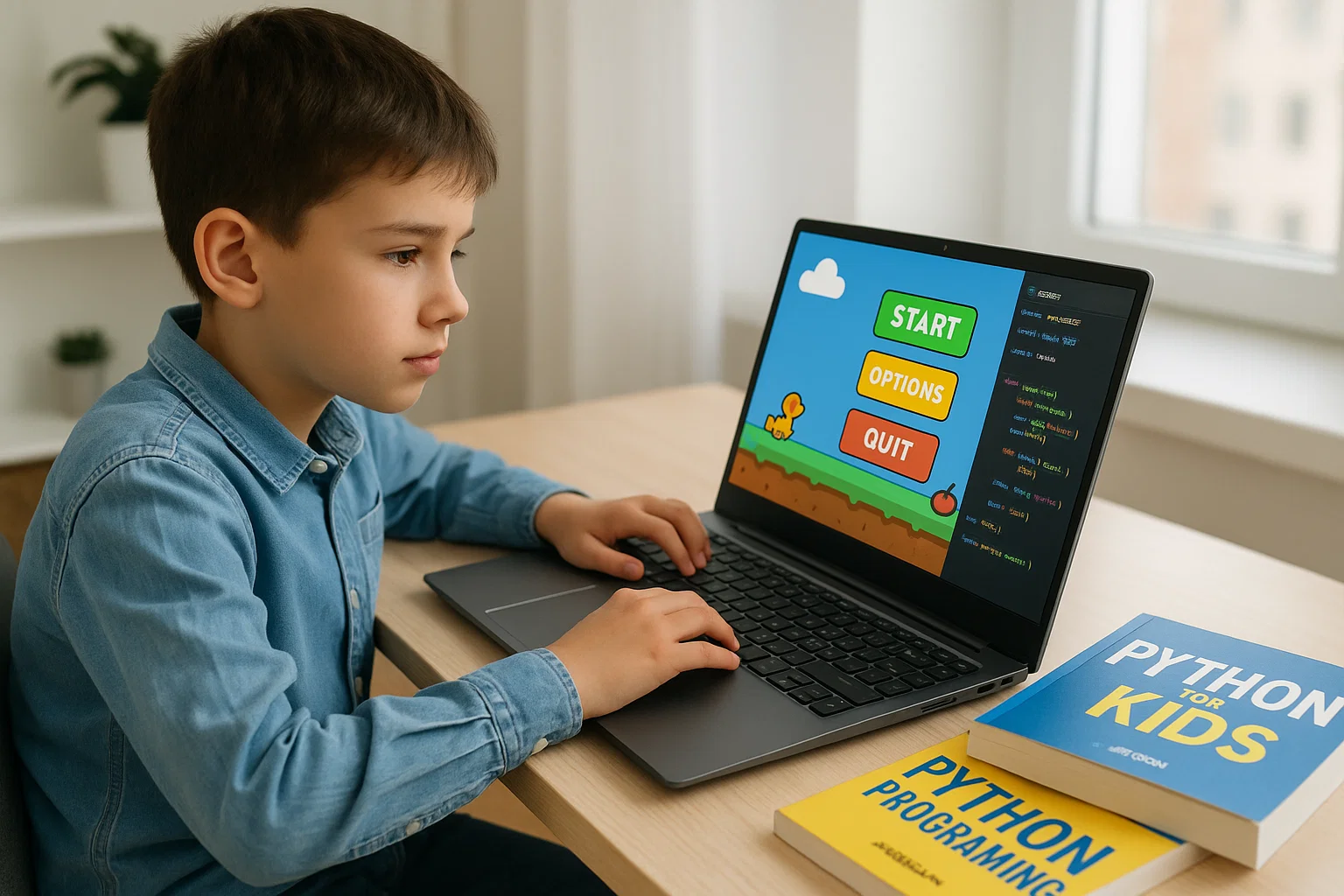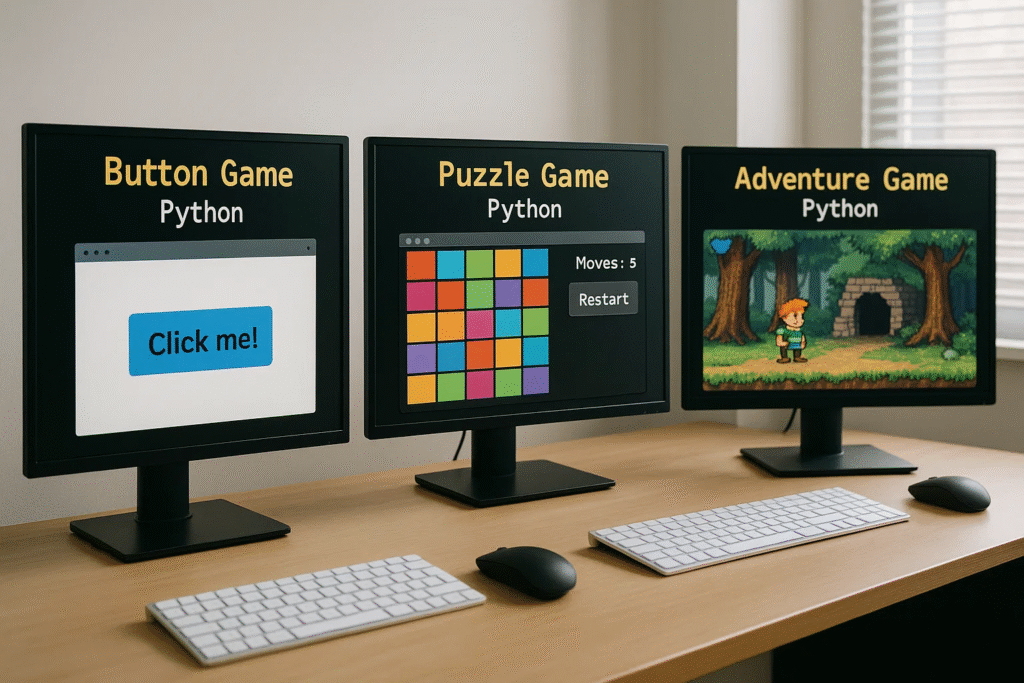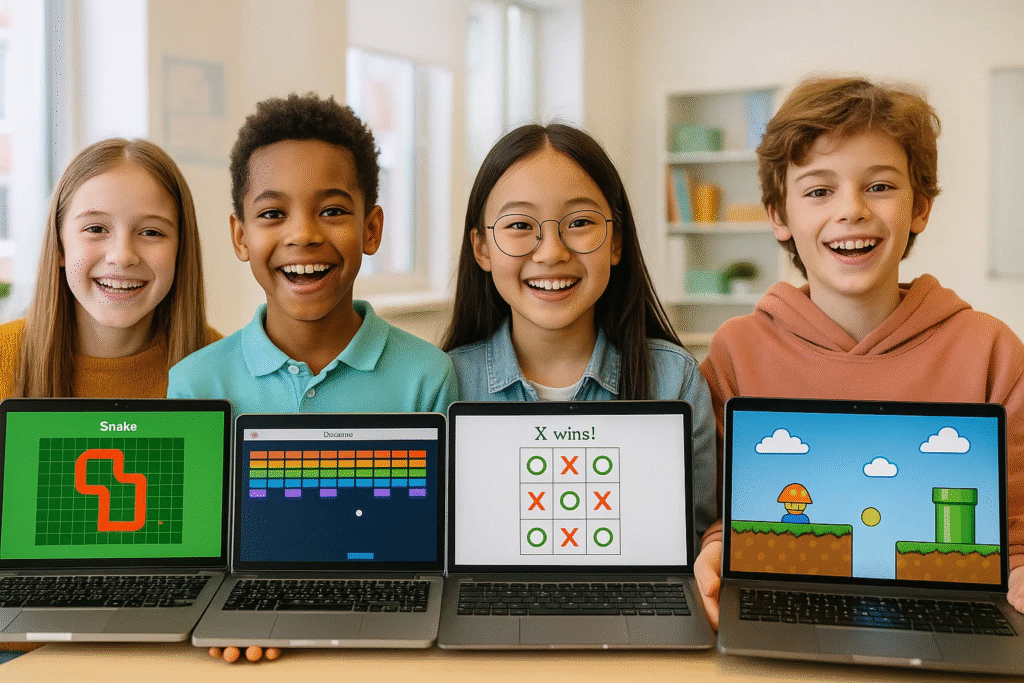
Reading Time: 9 mins

Is your child fascinated by video games but you’re concerned they’re spending too much time as passive consumers rather than active creators? Are you worried that traditional programming tutorials seem too abstract and boring for young learners who crave visual, interactive experiences? You’re facing the same challenge thousands of parents encounter when trying to bridge their child’s gaming interests with valuable learning opportunities.
The problem with most programming education is that it starts with text-based, command-line applications that feel disconnected from the exciting, colorful games kids actually enjoy playing. This disconnect often leads to frustration, loss of interest, and missed opportunities to develop crucial programming skills during the critical learning years.
Here’s where GUI games in Python become your perfect solution. By combining visual interfaces with game development, Python GUI games transform abstract programming concepts into engaging, interactive experiences that capture children’s imagination while building solid coding foundations. This comprehensive guide will show you exactly how GUI games work, why they’re perfect for young learners, and how to get started creating amazing visual games that both educate and entertain.
GUI games in Python represent a fascinating intersection of visual design and programming logic, where Graphical User Interface (GUI) elements create interactive gaming experiences that users can see, click, and manipulate with intuitive controls. Unlike text-based console applications, GUI games provide immediate visual feedback and engaging user interactions through buttons, images, animations, and responsive graphics.
Python’s versatility makes it an exceptional choice for GUI game development, offering multiple frameworks and libraries that cater to different skill levels and project complexity. The language’s readable syntax and beginner-friendly nature make it particularly suitable for young developers who want to create visually appealing games without getting overwhelmed by complex programming syntax.
When we talk about GUI games in Python, we’re referring to applications that combine several key elements: visual interfaces that users can interact with, game logic that responds to user actions, graphics and animations that provide engaging experiences, and event-driven programming that creates responsive gameplay. This combination makes Python GUI games an ideal entry point for children transitioning from visual programming languages like Scratch coding to more advanced text-based programming.
The beauty of Python GUI games lies in their immediate visual gratification. When children write code and instantly see colorful graphics, moving characters, or interactive buttons appear on screen, they experience the magic of creating something tangible and engaging. This visual feedback loop is crucial for maintaining motivation and building confidence in programming abilities.
At ItsMyBot, we’ve observed that students who start with GUI game development develop stronger programming fundamentals while maintaining higher engagement levels compared to those who begin with abstract console applications. The combination of creativity, logic, and immediate visual results creates an optimal learning environment for young programmers.
The distinction between GUI games and console games represents a fundamental shift in how users interact with programs and how developers approach game design. Understanding these differences helps parents and educators choose the most appropriate learning path for young programmers.
Visual Interface vs Text-Based Interaction
Console games rely entirely on text-based input and output, where players type commands and receive text responses. Think of early text adventure games where you might type “go north” or “take sword” to interact with the game world. While these games can be engaging, they require players to imagine the visual elements and memorize text commands.
GUI games, in contrast, provide visual elements that users can click, drag, or manipulate directly. Buttons replace typed commands, images represent game objects, and mouse movements control character actions. This visual approach aligns naturally with how children interact with modern technology and reduces the cognitive load of remembering specific command syntax.
Event-Driven Programming Model
Console games typically follow a linear execution model where the program asks for input, processes it, and provides output in a predictable sequence. GUI games use event-driven programming, where the program continuously listens for user actions (mouse clicks, key presses, window movements) and responds accordingly. This model more closely mirrors real-world interactions and helps children understand responsive programming concepts.
Immediate Visual Feedback
The most significant advantage of GUI games is their immediate visual feedback. When a child clicks a button in a Python calculator, they instantly see the result displayed. When they move a game character, the visual change happens immediately. This instant gratification maintains engagement and helps children understand cause-and-effect relationships in programming.

Python’s rich ecosystem includes several powerful libraries specifically designed for creating GUI games, each offering unique advantages and targeting different skill levels. Understanding these options helps developers choose the most appropriate tools for their projects and learning goals.
Tkinter: Built-in Simplicity
Tkinter comes pre-installed with Python, making it the most accessible option for beginners. While primarily designed for general GUI applications, Tkinter can create engaging simple games that teach fundamental programming concepts without requiring additional installations or complex setup procedures.
Tkinter’s strengths include zero setup requirements, simple widget-based interface design, perfect integration with Python basics, and excellent learning curve for beginners. It’s perfect for creating number guessing games, simple puzzles, and interactive quizzes that introduce GUI concepts gradually.
Pygame: Game Development Powerhouse
Pygame represents the gold standard for Python game development, offering comprehensive features for creating professional-quality games with advanced graphics, sound, and animation capabilities. Built on top of the SDL library, Pygame provides robust tools for handling sprites, collision detection, sound effects, and complex game logic.
Key Pygame advantages include professional-grade graphics handling, comprehensive audio support, extensive community resources and tutorials, and smooth transition to advanced game development concepts. This makes it ideal for creating Snake games and other classic arcade-style games.
Kivy and Arcade: Modern Alternatives
Kivy specializes in creating modern, touch-friendly applications that work seamlessly across different platforms, while Arcade offers a more modern, educational approach to Python game development with cleaner syntax and better learning resources.
Best 7 coding languages for game developers provides broader context on how Python fits into the overall game development landscape.

Creating your first GUI game in Python doesn’t require advanced programming knowledge. Let’s build a simple number guessing game using Tkinter that demonstrates core GUI game concepts while providing an engaging user experience.
Game Concept: Our number guessing game will generate a random number between 1 and 100, then challenge players to guess it using visual feedback and interactive buttons.
Essential Code Structure:
The basic framework includes importing necessary libraries (tkinter for GUI, random for number generation), creating a main window with title and size settings, adding interactive elements like buttons and text fields, implementing game logic that responds to user actions, and providing visual feedback for correct and incorrect guesses.
Key components include a welcome label that explains the game rules, an input field where players type their guesses, a submit button that triggers the checking process, a results label that displays feedback messages, and a restart button for playing multiple rounds.
This simple structure introduces essential GUI game concepts: window management, user input handling, event-driven responses, and visual feedback systems. The game teaches logical thinking while providing immediate visual rewards for participation and correct guesses.
Game Flow Design
Players see an attractive window with clear instructions and colorful interface elements. They enter their guess in a text field, click the “Guess” button, and immediately receive feedback indicating whether their guess was too high, too low, or correct. The game tracks the number of attempts and celebrates success with encouraging messages.
Understanding the fundamental building blocks of Python GUI games helps young developers create more sophisticated and engaging projects. These components work together to create seamless user experiences that combine entertainment with education.
Window Management: The main game window serves as the canvas for all visual elements. Proper window sizing, positioning, and configuration create professional-looking games that feel polished and complete. This includes setting appropriate dimensions, choosing attractive colors, and organizing elements logically.
Event Handling: GUI games respond to user actions through event handlers that detect mouse clicks, keyboard input, and window interactions. This event-driven approach teaches children about responsive programming and user experience design, helping them understand how modern applications work.
Visual Elements: Buttons, labels, text fields, and custom graphics combine to create engaging interfaces. Each element serves specific purposes: buttons trigger actions, labels display information, text fields accept user input, and graphics provide visual appeal that maintains player interest.
Game Logic Integration: Behind every visual element lies the game logic that determines how the program responds to user actions. This separation of visual design and logical processing teaches important programming architecture concepts that apply to all software development.
Different age groups benefit from different types of GUI game projects that match their cognitive development and programming experience. Here’s a progression of projects that build skills systematically while maintaining engagement and preventing frustration.

Ages 8-10: Simple Interactive Games
Beginning projects focus on basic interaction and immediate feedback. Color matching games teach visual recognition while introducing clicking mechanics. Simple calculator games combine math practice with GUI programming concepts. Animal sound quizzes use images and audio to create engaging learning experiences that build confidence in both programming and subject matter knowledge.
Ages 10-12: Logic-Based Challenges
Intermediate projects introduce more complex thinking while maintaining visual appeal. Memory card games teach sequence recognition and strategic thinking. Number pattern games combine mathematics with logical reasoning. Simple maze navigators introduce pathfinding concepts through click-to-move adventures that feel like real games.
Ages 12+: Complex Interactive Experiences
Advanced projects prepare young developers for real-world programming challenges. Strategy games incorporate multiple interactive elements and complex rule systems. Educational simulations visualize science or math concepts through interactive gameplay. Creative tools like drawing applications or music makers demonstrate how programming can support artistic expression.
Each project level introduces new programming concepts while building on previously learned skills. This progressive approach prevents overwhelming young learners while ensuring steady skill development that maintains long-term interest and motivation.
Developing GUI games in Python presents unique opportunities and challenges that differ from traditional programming projects. Understanding these aspects helps young developers create better games while avoiding common frustrations that can derail learning progress.
Essential Best Practices
Start simple and focus on completing working projects rather than attempting complex features. A functional simple game provides more learning value and confidence than an incomplete ambitious project. Plan visual layouts before coding by sketching interfaces and considering user interactions.
Test frequently during development to catch problems early and ensure visual elements work correctly across different screen sizes and user scenarios. Focus on user experience by creating clear buttons, readable text, and logical layouts that make games enjoyable and professional-looking.
Common Challenges and Solutions
Layout problems where visual elements appear incorrectly often frustrate beginners. Solution: Learn basic layout managers and test designs on different screen configurations. Event handling confusion about when and how user actions trigger responses requires practice with simple examples before attempting complex interactions.
Performance issues causing slow or frozen games usually result from inefficient code structure. Solution: Keep game loops simple and avoid unnecessary calculations in event handlers that run frequently.
Beginning your child’s GUI game development adventure requires the right approach, tools, and mindset. Success depends more on consistent practice and gradual skill building than on advanced technical knowledge or expensive equipment.

Environment Setup: Ensure Python is installed with IDLE or a beginner-friendly editor like Thonny. What is a variable in Python provides essential background knowledge for GUI game development.
Learning Progression: Start with Tkinter basics by creating simple windows with buttons and labels. Build your first simple game like a number guessing or color matching activity. Add visual polish with colors and improved layouts. Explore advanced libraries like Pygame for sophisticated graphics.
Creating Support: Encourage experimentation and celebrate small wins. Connect with coding communities and consider structured programs. How to support your child’s coding journey offers additional guidance for parents.
GUI games in Python represent the perfect bridge between children’s natural gaming interests and valuable programming education. By combining visual interfaces with logical thinking, these projects create engaging learning experiences that build lasting technical skills while providing immediate creative satisfaction.
The journey from simple Tkinter games to sophisticated Pygame projects mirrors natural programming skill development. Each successful project builds confidence, introduces new concepts, and prepares young developers for advanced challenges.
Remember that learning GUI game development requires patience, practice, and persistence. Every bug fixed and feature added contributes to deeper programming understanding that serves children throughout their educational and professional lives.
Ready to start your child’s GUI game development journey? Explore our comprehensive Python programming resources and transform screen time into creative learning time.
